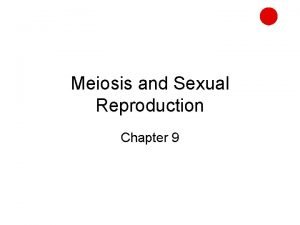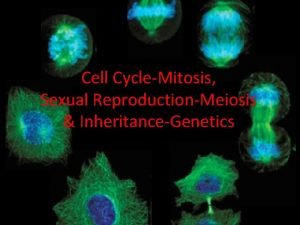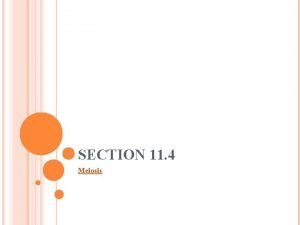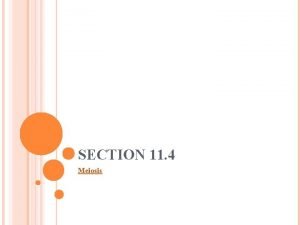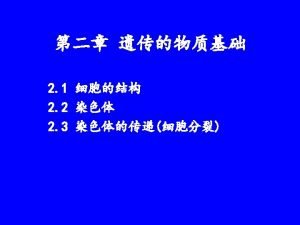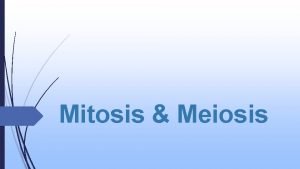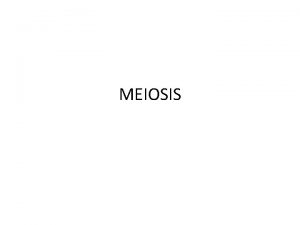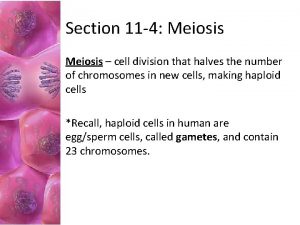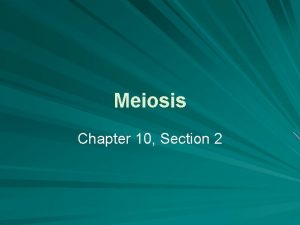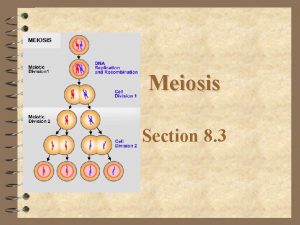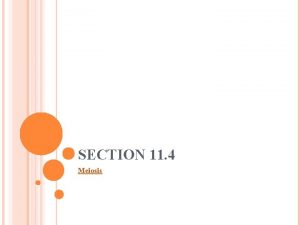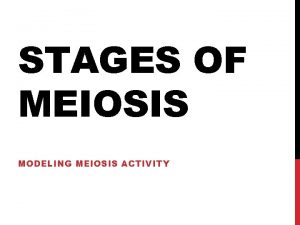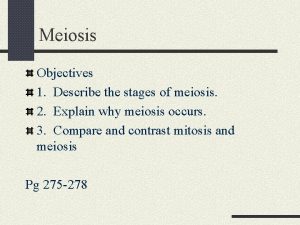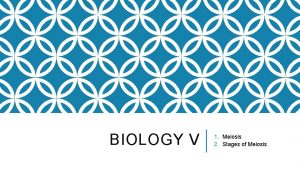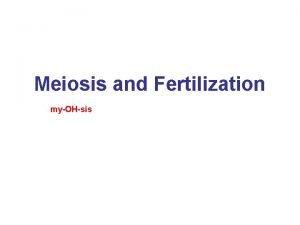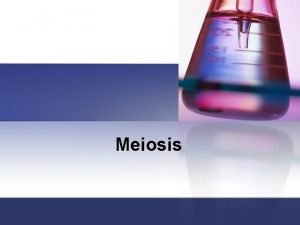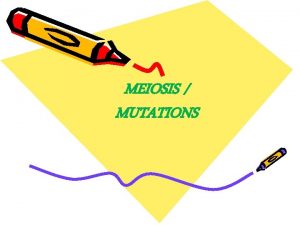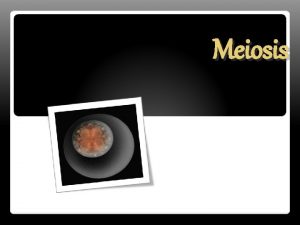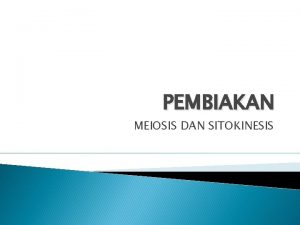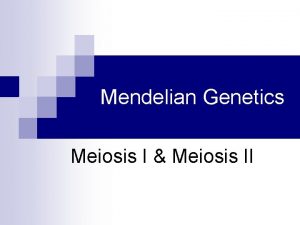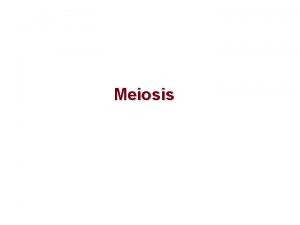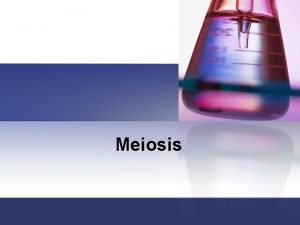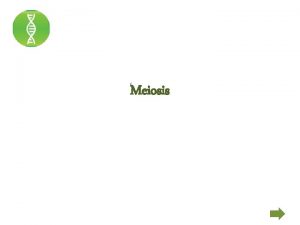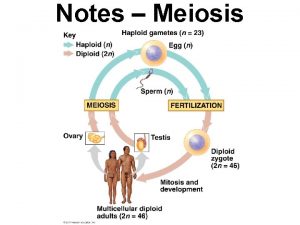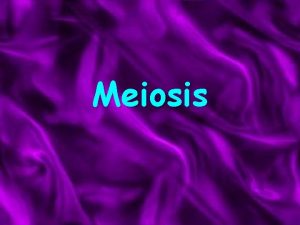SECTION 11 4 Meiosis A STAGES OF MEIOSIS























- Slides: 23

SECTION 11. 4 Meiosis

A) STAGES OF MEIOSIS http: //www. youtube. com/watch? v=D 1_-m. QS_FZ 0 1. Final product will be 4 haploid (half the number of chromosomes) cells 2. Make gamete cells (egg and sperm cells)

Meiosis: 2 divisions Sister chromatids separate Homologs separate Meiosis I (reduction division) Meiosis II (equational division) Diploid Haploid Result: one copy of each chromosome in a gamete.

A) STAGES OF MEIOSIS Interphasea) b) c) G 1 -growth S phase-replicate DNA (after this step the cell will have 96 chromosomes) G 2 -growth

A) STAGES OF MEIOSIS 1) Meiosis I a) Prophase (same as Mitosis w/ extra) 2. Crossing over: exchange pieces of chromosome between mother and father chromosomes a) genetic recombination: mixing up genes

The two chromosomes connected make a tetrad.

a) Prophase I Chromosomes with the same characteristics pair. Crossing over occurs. Chromosomes condense. Spindle forms. Nuclear membrane disappears.

Recombination (crossing over) n Occurs in prophase of meiosis I a A B C n b C A a B b c c Generates diversity Letters denote genes Case denotes alleles • Creates chromosomes with new combinations of alleles for genes A to C.

b) Metaphase I 1. Chromosome pairs align along the equator of the cell

c) Anaphase II Chromosome pairs separate and move to opposite poles. Independent assortment: random separation of chromosome pairs = genetic recombination

Telophase I Nuclear membrane reassemble. Spindle fibers disappear. Cytokinesis divides cell into two. Result: 2 Genetically different cells with 46 chromosomes

Meiosis I : reduction division Spindle fibers Nucleus Prophase I 96 Chromosomes Metaphase I 96 Chromosomes Nuclear envelope Anaphase I Telophase I 96 46 Chromosomes (Diploid)

Prophase II Nuclear membrane fragments. Spindle fibers form.

Metaphase II Chromosomes align along equator of cell.

Anaphase II Chromatids separate and move to opposite poles. This increases genetic diversity again.

Telophase II Nuclear membrane assembles. Spindle fibers disappears. Cytokinesis divides cell into two. Result: 4 genetically different cells with 23 chromosomes, Haploid Cells

A) STAGES OF MEIOSIS Results of Meiosis: 1) 4 Haploid cells are created 2) Contains half the # of chromosomes as original cell 3) Genetic variation will increase chance of survival

Mitosis Meiosis 2 Number of divisions 1 Number of daughter cells 2 4 Yes No Chromosome # Same as parent Half of parent When Throughout life At sexual maturity Role Growth and repair Sexual reproduction Genetically identical?

B) FORMATION OF GAMETES 1) Animal cell: meiosis occurs in reproductive organs a) Female: Ovary Male: Testis

SPERM AND EGG


First polar body may divide (haploid) a a X a Mitosis Oogonium (diploid) A X X Meiosis I X Primary oocyte (diploid) Polar bodies die Meiosis II (if fertilization occurs) A X Secondary oocyte (haploid) Ovum (egg) A X Second polar body (haploid) Mature egg

C) ASEXUAL AND SEXUAL REPRODUCTION 1) Asexual Reproduction: reproduction of offspring from 1 parent a) No genetic diversity 2) Sexual Reproduction: reproduction of offspring by a sex cell from each parent a) Results with genetic diversity
 Chapter 10 meiosis 1 and meiosis 2
Chapter 10 meiosis 1 and meiosis 2 Anaphase
Anaphase Chromosomes number is maintained mitosis or meiosis
Chromosomes number is maintained mitosis or meiosis Meiosis and genetic variation answer key
Meiosis and genetic variation answer key Differences between mitosis and meiosis
Differences between mitosis and meiosis Chapter 10 section 10.2 meiosis worksheet answer key
Chapter 10 section 10.2 meiosis worksheet answer key Where does meiosis occur
Where does meiosis occur Chapter 9
Chapter 9 Meiosis stages
Meiosis stages Telephase
Telephase Stages of prophase in meiosis
Stages of prophase in meiosis Reductional and equational division
Reductional and equational division Copyright
Copyright Meiosis stages
Meiosis stages Meiosis vs mitosis chart
Meiosis vs mitosis chart Meiosis 1
Meiosis 1 Sexual reproduction and genetics section 1 meiosis
Sexual reproduction and genetics section 1 meiosis Section 11-4 meiosis
Section 11-4 meiosis Section 11-4 meiosis answer key
Section 11-4 meiosis answer key Chapter 10 section 3 gene linkage and polyploidy
Chapter 10 section 3 gene linkage and polyploidy Chapter 10 section 10.2 meiosis worksheet answer key
Chapter 10 section 10.2 meiosis worksheet answer key Section 8-3 meiosis
Section 8-3 meiosis Section 11-4 meiosis
Section 11-4 meiosis End of meiosis 2
End of meiosis 2







